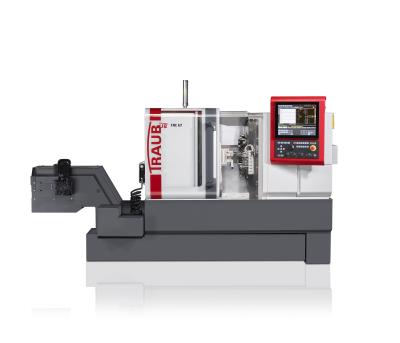
INDEX has announced the launch of the next generation of its TRAUB TNL12 sliding-headstock lathe for small part machining. Representing a comprehensive evolution of the machine, the new TNL12 incorporates a plethora of design changes that boost speed, flexibility and accuracy. The new machine provides an especially strong value proposition for medical manufacturers responsible for producing implants, bone screws and instruments for minimally invasive surgery.
Like its predecessor, the new TNL12 features four tool carriers that can be applied to a workpiece simultaneously, albeit with significant changes to the machine’s kinematics. While the front-working attachment and counter spindle were previously arranged on a single slide, they are now housed on separate slides. This eliminates potential interdependence between front-end and counter spindle machining, allowing for much greater flexibility in programming. Additionally, this design reduces the mass of both elements, allowing for faster and more dynamic machine response.
The features enabling rear-end machining also have undergone substantial changes. While the former model of the machine offered X-axis machining on the counter spindle, the new TNL12 provides full 3-axis machining in this position. A new back-working attachment offer six tool stations, with up to four allowing live tooling, as well as a flushing unit.
Overall tooling capacity has also been increased, with the capability to house up to 40 tools with the use of double and triple holders. This allows operators a greater degree of freedom to optimize machining of highly complex parts. Each of two 6-station tool turrets has its own servomotor and interpolated Y-axis, with chip-to- chip tool change times reduced to just 0.3 seconds.
While the previous generation TNL12 used belt drives on the main and counter spindles, the new machine incorporates fluid-cooled motor spindles with a maximum speed of 12,000 rpm. The new TNL12 also offers higher dynamic response thanks to low-mass clamping cylinders and a carbon sleeve for the guide bushing drive. The guide bushing is freely selectable, live or programmable, with the ability to adjust itself via a pneumatic servo valve.
Refinements to the TNL12’s overall structure include a non-hydraulic design, gray cast iron bed and thermo- symmetrical design that increases thermal accuracy and reduces warm-up times. These and other features combine to increase the stability of the machine, resulting in even higher accuracy and shorter cycle times.
The new TNL12 includes an 8-bar coolant pump, with the option to add one or two adjustable pumps capable of 20 bar to 120 bar. A 250-bar pump is also available for special applications. Coolant is cleaned by a compact belt filter and users can choose between a tray or conveyor for chip removal.
To maximize the potential for unmanned operation, the TNL12 offers options for automated rinsing, part removal via a small gripper and removal of long parts through the counter spindle. The machine can also be paired with a robot for machining of chucked parts. Furthermore, the machine can be equipped with an optional whirling unit with a +/- 30-degree swivel angle for high-speed whirling to a length of 75 mm.
The new TNL12 incorporates the current TRAUB TX8i-s control, which offers Industry 4.0 connectivity via INDEX’s iXworld platform. The folding and swiveling operating panel includes a 19" touchscreen and provides easy access to a networked production environment.
Users of the previous model of TNL12 will find it easy to implement the new machine within their operations, as it is backwards compatible with its predecessor’s tool holders for the turret and front- and back-working attachments.
Contact Details
Related Glossary Terms
- bushing
bushing
Cylindrical sleeve, typically made from high-grade tool steel, inserted into a jig fixture to guide cutting tools. There are three main types: renewable, used in liners that in turn are installed in the jig; press-fit, installed directly in the jig for short production runs; and liner (or master), installed permanently in a jig to receive renewable bushing.
- coolant
coolant
Fluid that reduces temperature buildup at the tool/workpiece interface during machining. Normally takes the form of a liquid such as soluble or chemical mixtures (semisynthetic, synthetic) but can be pressurized air or other gas. Because of water’s ability to absorb great quantities of heat, it is widely used as a coolant and vehicle for various cutting compounds, with the water-to-compound ratio varying with the machining task. See cutting fluid; semisynthetic cutting fluid; soluble-oil cutting fluid; synthetic cutting fluid.
- lathe
lathe
Turning machine capable of sawing, milling, grinding, gear-cutting, drilling, reaming, boring, threading, facing, chamfering, grooving, knurling, spinning, parting, necking, taper-cutting, and cam- and eccentric-cutting, as well as step- and straight-turning. Comes in a variety of forms, ranging from manual to semiautomatic to fully automatic, with major types being engine lathes, turning and contouring lathes, turret lathes and numerical-control lathes. The engine lathe consists of a headstock and spindle, tailstock, bed, carriage (complete with apron) and cross slides. Features include gear- (speed) and feed-selector levers, toolpost, compound rest, lead screw and reversing lead screw, threading dial and rapid-traverse lever. Special lathe types include through-the-spindle, camshaft and crankshaft, brake drum and rotor, spinning and gun-barrel machines. Toolroom and bench lathes are used for precision work; the former for tool-and-die work and similar tasks, the latter for small workpieces (instruments, watches), normally without a power feed. Models are typically designated according to their “swing,” or the largest-diameter workpiece that can be rotated; bed length, or the distance between centers; and horsepower generated. See turning machine.






